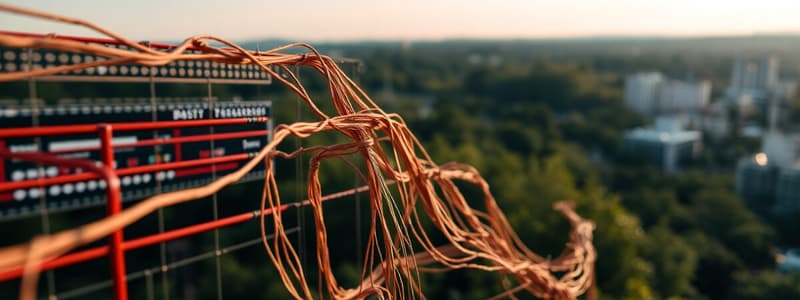Podcast
Questions and Answers
What distinguishes External Mode from Embedded Mode in Kafka Connect?
What distinguishes External Mode from Embedded Mode in Kafka Connect?
- External Mode uses a simpler configuration process than Embedded Mode.
- External Mode requires a separate cluster, whereas Embedded Mode operates within the same application. (correct)
- External Mode runs within the Kafka broker, while Embedded Mode runs outside it.
- External Mode can handle more connectors compared to Embedded Mode.
What is the primary purpose of using Kafka Connect?
What is the primary purpose of using Kafka Connect?
- To enable data integration between Kafka and external systems. (correct)
- To serialize data before it is sent to consumers.
- To enhance the security of Kafka clusters.
- To manage Kafka topics and partitions.
Which component is essential for configuring Kafka Connect Workers?
Which component is essential for configuring Kafka Connect Workers?
- Schema Registry
- Configuration Properties (correct)
- Connectors
- Task Management
Which action is involved in managing connectors within Kafka Connect?
Which action is involved in managing connectors within Kafka Connect?
When describing connectors, what typical information is provided?
When describing connectors, what typical information is provided?
What is the benefit of using converters in Kafka Connect?
What is the benefit of using converters in Kafka Connect?
What is the function of the Schema Registry in connection with Kafka Connect?
What is the function of the Schema Registry in connection with Kafka Connect?
What is a critical first step when verifying the Source Connector within Kafka Connect?
What is a critical first step when verifying the Source Connector within Kafka Connect?
What is the primary concern that complements the problem of storing data?
What is the primary concern that complements the problem of storing data?
What key functionality do modern stream processing systems provide?
What key functionality do modern stream processing systems provide?
Which technology or system is highlighted as an example of state-of-the-art stream processing?
Which technology or system is highlighted as an example of state-of-the-art stream processing?
What does the author suggest is a common issue faced by data engineers and scientists?
What does the author suggest is a common issue faced by data engineers and scientists?
How does the author describe the focus on data volume in today’s technological landscape?
How does the author describe the focus on data volume in today’s technological landscape?
What is the role of events in a business according to the content?
What is the role of events in a business according to the content?
What approach does the author suggest for mastering stream processing technologies?
What approach does the author suggest for mastering stream processing technologies?
Which of the following is NOT a focus of the mentioned stream processing systems?
Which of the following is NOT a focus of the mentioned stream processing systems?
What is included in the section on testing within the content?
What is included in the section on testing within the content?
What is the primary difference between stateless and stateful processing?
What is the primary difference between stateless and stateful processing?
Which method is specifically associated with assessing performance in a Kafka environment?
Which method is specifically associated with assessing performance in a Kafka environment?
Which component is directly responsible for transforming incoming data in a KStream?
Which component is directly responsible for transforming incoming data in a KStream?
What type of tests are emphasized for ensuring reliability in Kafka Streams?
What type of tests are emphasized for ensuring reliability in Kafka Streams?
What is the purpose of serialization in data processing?
What is the purpose of serialization in data processing?
Which of the following is a key component of monitoring in the content?
Which of the following is a key component of monitoring in the content?
What does the deployment section focus on primarily?
What does the deployment section focus on primarily?
What is a key benefit of building custom Serdes?
What is a key benefit of building custom Serdes?
Which topic discusses the strategy for upgrading components within the Kafka ecosystem?
Which topic discusses the strategy for upgrading components within the Kafka ecosystem?
Which of the following is NOT a typical use case for filtering data in streams?
Which of the following is NOT a typical use case for filtering data in streams?
What concept is covered under the monitoring section that helps track application metrics?
What concept is covered under the monitoring section that helps track application metrics?
Why is it important to define data classes in data processing applications?
Why is it important to define data classes in data processing applications?
What feature does sentiment analysis provide in relation to processing a Twitter stream?
What feature does sentiment analysis provide in relation to processing a Twitter stream?
Which of these does not belong in the operations section?
Which of these does not belong in the operations section?
What does merging streams typically involve?
What does merging streams typically involve?
What is a central focus for container orchestration in the deployment section?
What is a central focus for container orchestration in the deployment section?
Which of the following describes schema registry-aware Avro Serdes?
Which of the following describes schema registry-aware Avro Serdes?
Which of the following is critical when it comes to upgrading components in Kafka?
Which of the following is critical when it comes to upgrading components in Kafka?
In the context of adding a sink processor, what is its primary role?
In the context of adding a sink processor, what is its primary role?
What does the command 'kafka-topics --create --topic users --partitions 4 --replication-factor 1' accomplish?
What does the command 'kafka-topics --create --topic users --partitions 4 --replication-factor 1' accomplish?
Which flag is used with the kafka-topics command to display the configuration of a topic?
Which flag is used with the kafka-topics command to display the configuration of a topic?
In the specified command, why is the replication factor set to 1?
In the specified command, why is the replication factor set to 1?
What is the purpose of the kafka-console-producer command?
What is the purpose of the kafka-console-producer command?
What does the command 'kafka-topics --describe --topic users' return?
What does the command 'kafka-topics --describe --topic users' return?
Why is it recommended to set a higher replication factor in a production environment?
Why is it recommended to set a higher replication factor in a production environment?
When running the kafka-console-producer command, which property is set to parse the key?
When running the kafka-console-producer command, which property is set to parse the key?
What output do you expect when successfully creating the topic 'users'?
What output do you expect when successfully creating the topic 'users'?
Flashcards are hidden until you start studying
Study Notes
Kafka Topics
- Kafka Topics are the core unit of data organization in Kafka.
- Topics are used to store streams of records, enabling a persistent and scalable way to exchange data.
- Kafka-topics is a console script that facilitates the creation and management of Kafka Topics.
- To create a topic, the following command is used:
kafka-topics --bootstrap-server localhost:9092 --create --topic users --partitions 4 --replication-factor 1 - The
--bootstrap-serverflag specifies the host and port of the Kafka broker. - The
--topicflag defines the name of the topic to create. - The
--partitionsflag sets the number of partitions for the topic. - The
--replication-factorflag determines the number of copies of each partition for fault tolerance. - The
kafka-topicscommand also supports other functionalities, such as listing, describing, and deleting topics. - The
--describeflag provides information about a specific topic, including its configuration, partitions, and replicas. - The
kafka-console-producerscript is used to produce data to a Kafka topic. kafka-console-producer --bootstrap-server localhost:9092 --property key.separator=, --property parse.key=true --topic usersis the command to produce data.- The
--property key.separator=flag defines the separator between key and value. - The
--property parse.key=trueflag enables the parsing of the key. - The
--topicflag specifies the target topic for data production.
Studying That Suits You
Use AI to generate personalized quizzes and flashcards to suit your learning preferences.




